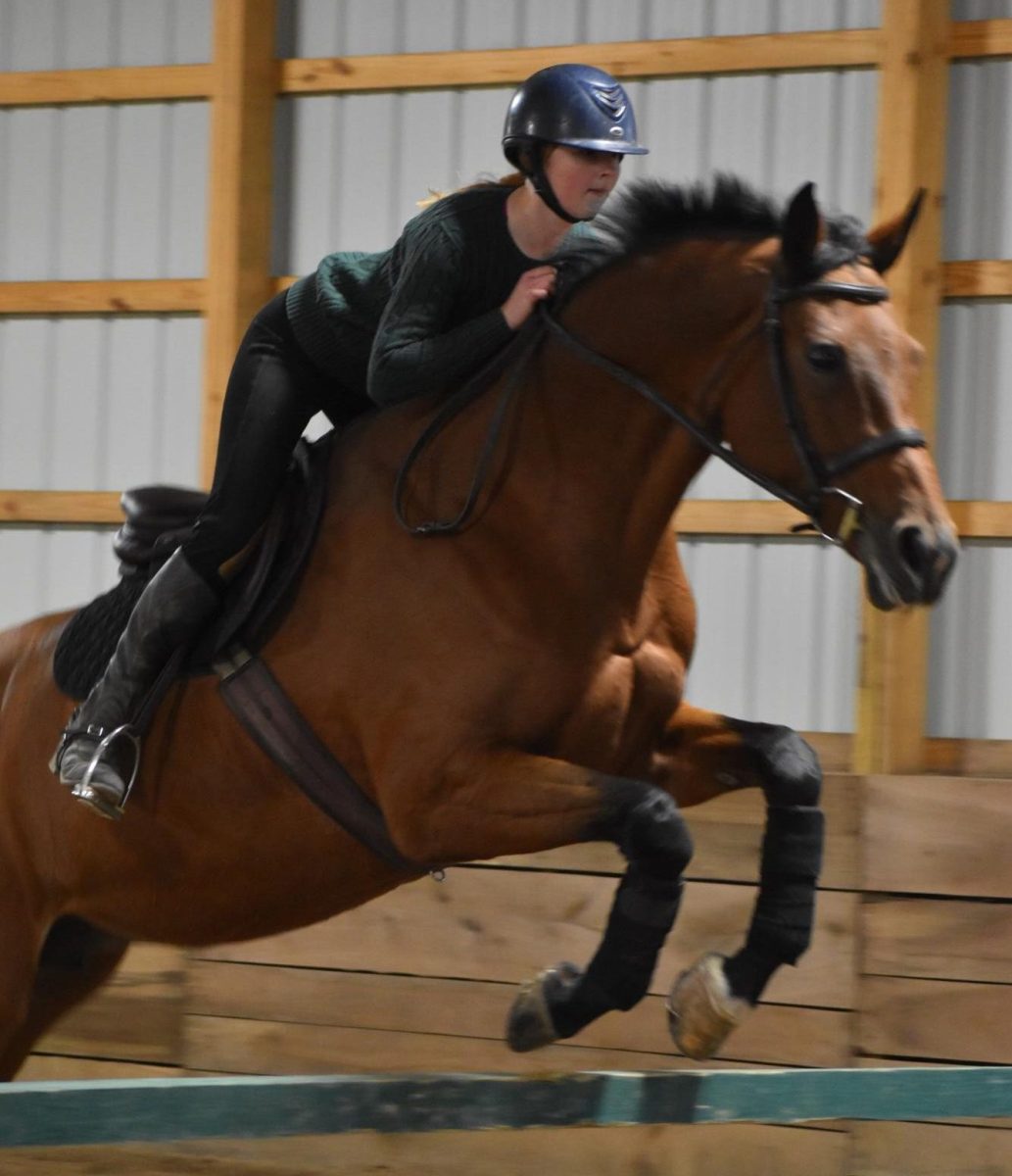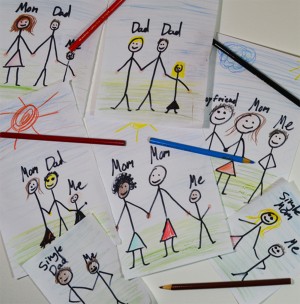While most students will stay home or go to a relative’s house to celebrate Thanksgiving with their families, junior Shelby Spitz said this holiday her family plans to celebrate not only in Carmel, but all over the Midwest during the short four-day break.

“I will be driving down to visit my grandpa, and then I will be driving to my dad’s house (where) we’ll have Thanksgiving with my dad’s girlfriend. Then we will probably drive to Springfield (IL) and have a big Thanksgiving dinner with my dad’s family. The next day, I’ll probably go down to Louisville and have a belated Thanksgiving with my step-family,” Spitz said.
Spitz’s extensive travels are just one of the numerous unique components of her life in a nontraditional family.
“I think of my family as the ‘(My) Big Fat Greek Wedding’ family because there are so many aspects of it (but), we never really all get together,” she said.
Her immediate family consists of her sister, mother and her mother’s fiancé, who Spitz said she considers as her “step-father” even though they aren’t married and, according to Spitz, most likely won’t get married. She also has older “step-siblings” who have children that she said she considers to be her own nieces and nephews.
“It’s kind of weird, the age difference. So I guess that’s what makes us untraditional, the age gap as well as the (step-family) aspect of it,” Spitz said.
Spitz’s unconventional family is not rare. According to a 2010 Pew Research Center poll and a new book called Counted Out by Brian Powell, the number of nontraditional families—not just a married heterosexual couple and their children—has risen greatly over the past 50 years. Many new forms of families have arisen, and along them, the definition of a family has changed.
Evolving Views
The definition of a family has become more inclusive over time, according to Jessica Calarco, associate professor of sociology at IU.
“I think that our society is sort of influx in terms of (how) the public is defining families,” Calarco said. “We’re seeing that both in terms of the shift away from a traditional family where most people live and also in shifts of people’s attitudes towards those families.”
According to Spitz, more people are choosing to define family by more than just genetic attachment.
“I think it’s kind of moved from just your biological family to your friends are sort of considered your family, and people you’re close to are considered your family. So I don’t think it has to be like you share genetics with them for you to consider them family,” Spitz said.
The rise in nontraditional families, according to the Pew Research Center poll, is because of several factors. For one, the number of children born to unmarried mothers has increased from five percent in 1960 to 41 percent in 2008, and is still rising. In addition, the number of married adults has decreased 20 percent since 1960 while the number of cohabitations— couples living together as unmarried partners—has doubled since 1990. These trends, according to the poll, are said to have increased the number of new arrangements in a family.
Calarco said it’s hard to tell whether a changing definition of family caused the growth in nontraditional families, or if the increase in diverse households changed the definition. Ultimately, she said, the more people encounter households that diverge from the traditional model, the more they will recognize them as legitimate families.
“It’s kind of the chicken and the egg problem,” Calarco said. “It seems like these trends in terms of (nontraditional families), they seemed to have started before the shift in (the definition of a family) and as those families have become more common, attitudes have started to shift to accept those households as families.”

Like Spitz, junior William “Will” Arnold, who was raised in a single-parent family, said he has seen growth in the number of nontraditional families.
“It’s becoming the new trend. You don’t see a lot of traditional families that much anymore,” Arnold said.
This new attitude of acceptance, Calarco said, is the case especially with the families of same-sex couples.
“People today are much more likely to know someone who is gay or lesbian and the more people you know that are in these types of same-sex relationships, the more open people seem to be to recognizing their families as families,” she said.
While neither Spitz or Arnold said they know any same-sex couples with kids, both said they see them as families.
“They are giving that child the love and care they need just like a traditional or nontraditional family would,” Arnold said.
Calarco said the Millennial generation—those ages 18 to 29—are most open to these new family groups. She said this is because young people have been more exposed to these nontraditional families and therefore tend to be more open to them. Their views on marriage also reflect these ideas.
“More young people are also more likely to say that marriage isn’t as important to the definition of a family as children are. For example they tend to focus much more on people wanting to be together and that marriage is becoming, in terms of young people’s definitions, less of a requirement, in terms of what makes the family,” Calarco said.
Spitz said she does not believe marriage is a determining factor in defining a family, as did Arnold.
“You don’t have to have two parents in the same household to be a family. Being loved and cherished by the people around is all the family you need,” Arnold said.
From people in older generations, Spitz said she has seen less acceptance of her atypical family.
“People of the older age are kind of discriminatory towards (my parents’ divorce),” Spitz said.

Despite what some might believe, nontraditional families do not inherently experience more or fewer challenges than traditional ones, Calarco said. She said researchers have found neither benefits nor harms associated with families of either same-sex or heterosexual parents. Children raised by either type of parents experience the same academic and psychological development, gender identity and sexual orientation. No arrangement of family is any “better” than another, Calarco said.
But each family does have its own different problems and advantages. Spitz said one of her biggest challenges is distance. Especially around the holidays, in order to see all of her family, Spitz travels to many different places in the Midwest.
“As I (get) older I see my dad less and less and all of his family and all my mom’s family lives in Illinois,” Spitz said. “Then my step-dad’s family is all in Kentucky and Warren (IN), so I feel like we’ve kind of lost some of that closeness.”
The plus side to her situation, according to Spitz, is getting to experience each holiday in many different settings.
“I think it’s kind of nice to go all over and see all the different ways you can celebrate different holidays,” she said.
Spitz also said she enjoys the large number of people in her family. She said that if she ever had a problem, before she could only go to her mother, father or sister. Now, she said, she can go to a number of different family members; there’s always someone to talk to.
For Arnold, finances are one of the biggest problems for his family, he said. With only one parent to support his family income, he said, his mother has to work long hours to make up the difference. However, Arnold said, this obstacle has made his family stronger.
“It gives me a better appreciation of the sacrifices that my mother has made for me everyday, and it also brings me and my mother closer together,” Arnold said.
Spitz also attributes a closer relationship with her mother to her nontraditional family. Before her parents’ divorce, she said members of her family weren’t very open with one another. However, when Spitz met her step-family she said her family became closer.
“(My step-family had) just a really open family environment,” Spitz said. “So I would say that kind of changed my relationship with my mom; I guess I became more trusting and more open with my mom.”
While both Spitz and Arnold say their families are closer because of their unusual arrangement, this isn’t necessarily a trend in unconventional families. According to Calarco, there has not been any substantial research about the extent to which these new families promote closer relationships and greater happiness.
The Next Generation

Young Americans in nontraditional families typically have different views on marriage and how they want their family to be structured in the future, Calarco said, especially children whose parents have divorced.
“(Divorce) can change their attitude somewhat in (marriage) and that also seems to be driving some of the young people’s attitudes towards not being married as central a component to family. It used to be with (mostly) divorced kids (but now all children are) more open to these family forms and new changes in the way that we think about family,” Calarco said.
Spitz, whose parents divorced when she was young, said that she is now cautious about marriage and reluctant to divorce.
Arnold’s views on marriage are also different because he has a single parent.
“It does not matter to me if I am married or not, just as long as I can provide for my child, and they know I love them unconditionally,” he said.
Also as a result of their atypical families, Spitz and Arnold said they are more accepting of diversity.
“After, you know, meeting (my step-family) and interacting with them, I kind of see that people may be different than your family,” Spitz said, “but it doesn’t mean it’s wrong.”


































![British royalty are American celebrities [opinion]](https://hilite.org/wp-content/uploads/2024/03/Screenshot-2024-03-24-1.44.57-PM.png)


















![Review: “Suits” is a perfect blend of legal drama and humor [MUSE]](https://hilite.org/wp-content/uploads/2024/04/unnamed-1.png)
![Chelsea Meng on her instagram-run bracelet shop [Biz Buzz]](https://hilite.org/wp-content/uploads/2024/04/IMG_2446-1200x838.jpg)
![Review: Quiet on Set: The Dark Side of Kids TV is the long awaited exposé of pedophilia within the children’s entertainment industry [MUSE]](https://hilite.org/wp-content/uploads/2024/04/unnamed.jpg)
![Review: “The Iron Claw” cannot get enough praise [MUSE]](https://hilite.org/wp-content/uploads/2024/04/unnamed.png)
![Review: “The Bear” sets an unbelievably high bar for future comedy shows [MUSE]](https://hilite.org/wp-content/uploads/2024/03/unnamed.png)
![Review in Print: Maripaz Villar brings a delightfully unique style to the world of WEBTOON [MUSE]](https://hilite.org/wp-content/uploads/2023/12/maripazcover-1200x960.jpg)
![Review: “The Sword of Kaigen” is a masterpiece [MUSE]](https://hilite.org/wp-content/uploads/2023/11/Screenshot-2023-11-26-201051.png)
![Review: Gateron Oil Kings, great linear switches, okay price [MUSE]](https://hilite.org/wp-content/uploads/2023/11/Screenshot-2023-11-26-200553.png)
![Review: “A Haunting in Venice” is a significant improvement from other Agatha Christie adaptations [MUSE]](https://hilite.org/wp-content/uploads/2023/11/e7ee2938a6d422669771bce6d8088521.jpg)
![Review: A Thanksgiving story from elementary school, still just as interesting [MUSE]](https://hilite.org/wp-content/uploads/2023/11/Screenshot-2023-11-26-195514-987x1200.png)
![Review: When I Fly Towards You, cute, uplifting youth drama [MUSE]](https://hilite.org/wp-content/uploads/2023/09/When-I-Fly-Towards-You-Chinese-drama.png)
![Postcards from Muse: Hawaii Travel Diary [MUSE]](https://hilite.org/wp-content/uploads/2023/09/My-project-1-1200x1200.jpg)
![Review: Ladybug & Cat Noir: The Movie, departure from original show [MUSE]](https://hilite.org/wp-content/uploads/2023/09/Ladybug__Cat_Noir_-_The_Movie_poster.jpg)
![Review in Print: Hidden Love is the cute, uplifting drama everyone needs [MUSE]](https://hilite.org/wp-content/uploads/2023/09/hiddenlovecover-e1693597208225-1030x1200.png)
![Review in Print: Heartstopper is the heartwarming queer romance we all need [MUSE]](https://hilite.org/wp-content/uploads/2023/08/museheartstoppercover-1200x654.png)






















![Review: Ladybug & Cat Noir: The Movie, departure from original show [MUSE]](https://hilite.org/wp-content/uploads/2023/09/Ladybug__Cat_Noir_-_The_Movie_poster-221x300.jpg)

![Review: Next in Fashion season two survives changes, becomes a valuable pop culture artifact [MUSE]](https://hilite.org/wp-content/uploads/2023/03/Screen-Shot-2023-03-09-at-11.05.05-AM-300x214.png)
![Review: Is The Stormlight Archive worth it? [MUSE]](https://hilite.org/wp-content/uploads/2023/10/unnamed-1-184x300.png)




